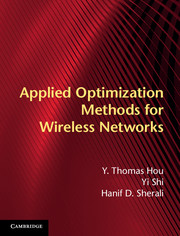Book contents
- Frontmatter
- Dedication
- Contents
- Preface
- Acknowledgments
- Copyright Permissions
- 1 Introduction
- Part I Methods for Optimal Solutions
- Part II Methods for Near-optimal and Approximation Solutions
- Part III Methods for Efficient Heuristic Solutions
- 10 An efficient technique for mixed-integer optimization
- 11 Metaheuristic methods
- Part IV Other Topics
- References
- Index
10 - An efficient technique for mixed-integer optimization
from Part III - Methods for Efficient Heuristic Solutions
Published online by Cambridge University Press: 05 May 2014
- Frontmatter
- Dedication
- Contents
- Preface
- Acknowledgments
- Copyright Permissions
- 1 Introduction
- Part I Methods for Optimal Solutions
- Part II Methods for Near-optimal and Approximation Solutions
- Part III Methods for Efficient Heuristic Solutions
- 10 An efficient technique for mixed-integer optimization
- 11 Metaheuristic methods
- Part IV Other Topics
- References
- Index
Summary
Remember, happiness doesn't depend upon who you are or what you have; it depends solely upon what you think.
Dale CarnegieSequential fixing: an introduction
In Chapter 5, we presented a branch-and-bound framework for solving mixed-integer nonlinear programs (MINLPs), which can be used to solve a broad class of problems. Furthermore, it can guarantee a (1 − ∊)-optimal solution for any given ∊ ≥ 0 but its worst-case complexity is exponential. In this chapter, we present another technique called sequential fixing (SF) to solve certain mixed-integer optimization problems. SF is designed to iteratively determine (fix) binary integer variables. Unlike branch-and-bound, it is a heuristic procedure and has polynomial-time complexity. Nevertheless, it is a very efficient technique, and, in a number of problem instances, we found that this technique can offer highly competitive solutions.
The basic idea behind SF is as follows. For some mixed-integer optimization problems, such as certain MINLP and any mixed-integer linear programming (MILP), if we were able to set the optimal values for all the integer variables and thereby reduce the original problem to an LP, then we can solve the reduced problem optimally in polynomial time. Thus, the key challenge in such contexts is how to determine the values for all the integer variables. This can be done by examining the linear or continuous relaxation of the original problem, which is obtained by relaxing all the integer variables to continuous variables.
- Type
- Chapter
- Information
- Applied Optimization Methods for Wireless Networks , pp. 245 - 261Publisher: Cambridge University PressPrint publication year: 2014



